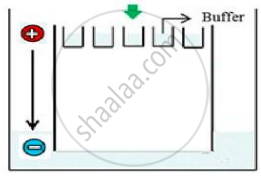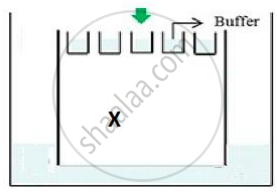Advertisements
Advertisements
प्रश्न
Carefully observe the given picture. A mixture of DNA with fragments ranging from 200 base pairs to 2500 base pairs was electrophoresed on agarose gel with the following arrangement.

(a) What result will be obtained on staining with ethidium bromide? Explain with reason.
(b) The above setup was modified and a band with 250 base pairs was obtained at X.

What change(s) were made to the previous design to obtain a band at X? Why did the band appear at position X?
उत्तर
(a) No bands will be obtained as all DNA will be seen in the well only; DNA fragments being negatively charged will not move towards the negative end/cathode. DNA being negatively charged will remain stationed at the positive end/anode end of the agar block.
(b)
- The position of the positive terminal/end/anode and the negative terminal/end/cathode was inter-changed.
- The fragment with the least base pairs will get separated faster and move faster to the anode end.
APPEARS IN
संबंधित प्रश्न
Explain with the help of a suitable example the naming of a restriction endonuclease.
How does a restriction nuclease function? Explain
Name and describe the technique that helps in separating the DNA fragments formed by the use of restriction endonuclease
Collect 5 examples of palindromic DNA sequences. Better try to create a palindromic sequence by following base-pair rules.
Explain the roles of the following with the help of an example each in recombinant DNA technology :
Restriction Enzymes
Answer the following question.
Write the use of restriction endonuclease in the formation of recombinant DNA.
Give a reason why :
Single cloning site is preferred in a vector.
A specific recognition sequence identified by endonucleases to make cuts at specific positions within the DNA is ______
Which of the given statements is correct in the context of visualizing DNA molecules separated by agarose gel electrophoresis?
The role of DNA ligase in the construction of a recombinant DNA molecule is ______.
